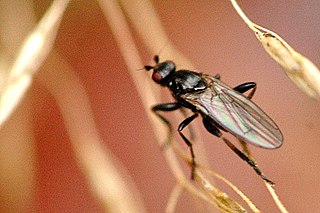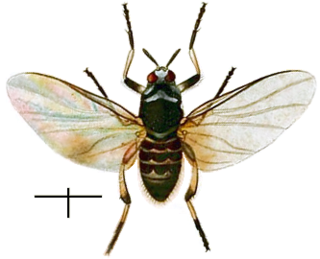
Carpenter bees are species in the genus Xylocopa of the subfamily Xylocopinae. The genus includes some 500 bees in 31 subgenera. The common name "carpenter bee" derives from their nesting behavior; nearly all species burrow into hard plant material such as dead wood or bamboo. The main exceptions are species in the subgenus Proxylocopa; they dig nesting tunnels in suitable soil.

Sphaeroceridae are a family of true flies in the order Diptera, often called small dung flies, lesser dung flies or lesser corpse flies due to their saprophagous habits. They belong to the typical fly suborder Brachycera as can be seen by their short antennae, and more precisely they are members of the section Schizophora. There are over 1,300 species and about 125 genera accepted as valid today, but new taxa are still being described.

Mantispidae, known commonly as mantidflies, mantispids, mantid lacewings, mantisflies or mantis-flies, is a family of small to moderate-sized insects in the order Neuroptera. There are many genera with around 400 species worldwide, especially in the tropics and subtropics. Only 5 species of Mantispa occur in Europe.

The Micropezidae are a moderate-sized family of acalyptrate muscoid flies in the insect order Diptera, comprising about 500 species in about 50 genera and five subfamilies worldwide,. They are most diverse in tropical and subtropical habitats, especially in the Neotropical Region.

The Stephanidae, sometimes called crown wasps, are a family of parasitoid wasps placed in the superfamily Stephanoidea, which has at least 345 living species in 11 genera. The family is considered cosmopolitan in distribution, with the highest species concentrations in subtropical and moderate climate zones. Stephanidae also contain four extinct genera described from both compression fossils and inclusions in amber.

The minute black scavenger flies or "dung midges", are a family, Scatopsidae, of nematoceran flies. Despite being distributed throughout the world, they form a small family with only around 250 described species in 27 genera, although many await description and doubtless even more await discovery. These are generally small, sometimes minute, dark flies, generally similar to black flies (Simuliidae), but usually lacking the humped thorax characteristic of that family.

Troctomorpha is a suborder of barklice, booklice, and parasitic lice in the order Psocoptera. There are more than 30 families and 5,800 described species in Troctomorpha.

Simulium is a genus of black flies, which may transmit diseases such as onchocerciasis. It is a large genus with several hundred species, and 41 subgenera.

Ectopsocus is a genus of psocoptera in the family Ectopsocidae.

Sarcophaga is a genus of true flies and the type genus of the flesh-fly family (Sarcophagidae). The members of this cosmopolitan genus are frequently known as common flesh flies.

The Pyrgotidae are an unusual family of flies (Diptera), one of only two families of Cyclorrhapha that lack ocelli. Most species are "picture-winged", as is typical among the Tephritoidea, but unlike other tephritoids, they are endoparasitoids; the females pursue scarab beetles in flight, laying an egg on the beetle's back under the elytra where the beetle cannot reach it. The egg hatches and the fly larva enters the body cavity of the beetle, feeding and eventually killing the host before pupating. In the United States, some species of Pyrgota and Sphecomyiella can be quite common in areas where their host beetles are abundant. Like their host beetles, these flies are primarily nocturnal, and are often attracted to artificial lights.

The Richardiidae are a family of Diptera in the superfamily Tephritoidea.
Formosia is a genus of parasitic flies in the family Tachinidae. There are more than 20 described species in Formosia.

Rutilia is a large genus of medium to large (>20mm) flies in the family Tachinidae native to Australia and the Oriental region, though notably absent from New Zealand. Like the vast majority of tachinid flies, Rutilia species are parasitoids of other insects, specifically Rutilia are known to be parasitoids of late instar larvae of Scarabaeidae.

Lichtwardtia is a genus of fly in the family Dolichopodidae. It is considered to be a synonym of Dolichopus by Scott E. Brooks (2005), but not by other authors. Before this, it was considered a possible subgenus of Pterostylus by Oleg Negrobov (1979).

Sciapodinae is a subfamily of flies in the family Dolichopodidae.
Eupyrgota is a genus of flies in the family Pyrgotidae. A number of its species were originally from Apyrgota and Taeniomastix, which in 2014 were made synonyms of Eupyrgota by V. Korneyev.

Limosininae is a subfamily of flies belonging to the family Sphaeroceridae, the lesser dung flies.

Nanopsocetae is an infraorder of psocids in the order Psocoptera. There are more than 20 families and 5,200 described species in Nanopsocetae.
Pamphaginae is a subfamily of grasshopers, with species found in Africa and Asia.














